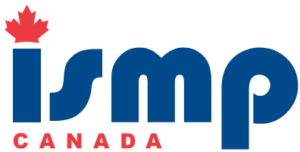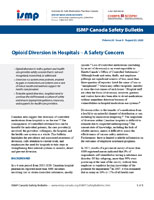- Opioid diversion is both a patient and health care provider safety concern that is not well recognized, researched, or addressed.
- Diversion is a system-level problem, enabled by gaps in medication-use systems and a lack of robust health and wellness support for health care providers.
- To tackle opioid diversion, hospitals need to continue the shift towards a culture of safety and ensure appropriate guidance, resources, and supports for health care providers.
INTRODUCTION
Canadian data suggest that diversion of controlled medications from hospitals is on the rise.1-3 The consequences of controlled substance loss can be harmful for individual patients, the care provider(s) involved, the providers’ colleagues, the hospital, and the health care system as a whole. This bulletin highlights the prevalence and associated awareness of diversion, calls attention to current work, and emphasizes the need for hospitals to take steps in strengthening their internal systems to monitor, detect and prevent diversion.
BACKGROUND
In a 4-year period from 2015 to 2019, Canadian hospital pharmacies reported more than 3000 incidents involving lost or stolen controlled substances, mostly opioids.4 Loss of controlled medications (including by an act of diversion) is an event reportable to Health Canada’s Office of Controlled Substances.5 Although break-and-enter, thefts, and employee pilferage are significant sources of loss, more than three-quarters of reporters listed the cause of loss as “unexplained”,4 which may reflect hospitals’ inability to trace the root causes of such losses.1 Hospital staff are often the focus of diversion, however, patients and visitors have also been able to divert medications without immediate detection because of vulnerabilities in hospital medication-use systems.6
Diversion refers to the transfer of a medication from a lawful to an unlawful channel of distribution or use, including by medication tampering.6,7 The magnitude of diversion within Canadian hospitals is difficult to estimate due to suspected underreporting.2 The current state of knowledge, including the lack of reliable metrics, makes it difficult to assess the effectiveness of various safety initiatives. Furthermore, there is limited available information on the outcomes of employee assistance programs.
In 2015, results of a provincial survey of more than 4000 registered nurses indicated that 3% of respondents self-identified as having a substance use disorder. Of this subgroup, more than 90% were practicing at the time of the survey, without their employer or regulator having knowledge of the potential for impairment.8 In 2007, it was estimated that as many as 10% to 15% of all health care providers will inappropriately use substances over their careers.9 Between 1991 and 2001, 80% of US anesthesiology residency programs reported experience with impaired residents, and 19% of the programs reported at least one death.10
EXAMPLES OF REPORTS
A nurse was accused of accessing patient health records at a Canadian hospital for the purpose of using patients’ information to obtain opioids.11
An anesthesiologist working in a Canadian hospital who did not return to work after a break was found deceased in the bathroom. A syringe containing fentanyl residue was found nearby, and an obvious injection site was noted on the body.12
In the United States, a medical technician infected with hepatitis C was discovered to be tampering with syringes of narcotics that were obtained from a cardiac catheterization lab. After self-injecting the opioid, the used syringes were refilled with saline, which were later used in patient care. Testing of more than 1000 patients revealed that at least 32 had been infected with hepatitis C through these acts of diversion.13
PATIENT SAFETY RISKS
Diversion of medications represent a risk not only to the person taking the medication, but also to patients, colleagues, the hospital, and the health care system as a whole. For example, impaired providers may have lapses in judgment that could harm patients.8 In instances where medications intended for patients are not administered, symptoms, such as pain, are left untreated. Patients may be placed at further risk by decisions (e.g., prescription of increasing opioid doses to address lack of pain control) based on incorrect documentation of medication use (e.g., medication administration record reflecting doses dispensed, but not actually administered).
Colleagues may be unwitting participants in diversion during sign-off for witnessed medication wastage or in administration of a contaminated product. Finally, public trust in the hospital organization may be eroded, and there can be significant costs to the health care system related to interventions required to investigate, treat and follow-up patients or staff harmed by diversion.
DRUG DIVERSION AND CULTURE OF SAFETY
Tackling diversion requires an examination of the work environment, analysis of medication processes and procedures, and provision of assistance and support to the health care workers involved. Incidents of diversion are often treated as personal failings, with punishment, termination, and retraining seen as the most effective strategies to mitigate the problem. Colleagues who recognize suspicious behaviour (e.g., frequent off-shift appearance of a colleague at the hospital) or signs of substance use disorder14 may be reluctant to report their concerns for fear of causing a coworker to lose his/her job. Many practitioners who themselves are suffering from a substance use disorder do not seek help because of the stigma and shame that may be attached to their disease.8
A continued shift towards a positive safety culture, away from blaming the individual, to addressing the gaps within the medication-use system, is required. Although drug diversion is an intentional act that contravenes established good practices, regulatory standards and professional expectations, it is also a symptom of a larger problem. Just as changes have been made to advance medication safety through reporting and learning from medication incidents, a similar strategy is needed to further knowledge about diversion. There exist underlying system-based contributing factors throughout the medication-use process, and thus there are opportunities for system-based mitigation strategies.1
EXAMPLES OF RECENT WORK
An extensive scoping review of the literature on controlled substance diversion was completed in 2019.1 Medication-use systems in hospitals were reviewed to identify gaps that allow for diversion and to explore related safeguards aimed at prevention.
The Canadian Society of Hospital Pharmacists created a comprehensive guideline with recommendations,15 to improve the identification of diversion and implementation of preventive measures. In particular, the new guideline calls on hospitals to establish a multidisciplinary diversion prevention committee, including a diversion prevention specialist.
The Ontario College of Pharmacists released its Framework for Improving the Safety and Security of Controlled Substances in Hospital Risk Areas,16 which includes 13 system-based recommendations for hospitals to reduce the risk of diversion.
In response to a proposal to support Canadian hospitals in assessing their practices, CIHR awarded a grant for the development of an online risk assessment tool based on best practices described in the literature.17
CONCLUSION
Canadian hospitals are recognizing the risk of harm from diversion of opioids. Evidence-based guidance and tools are needed to improve detection of diversion, to strengthen investigation and analysis, and to identify effective strategies for addressing losses of controlled substances. Organizations will need to undertake multiple, overlapping efforts to prevent drug diversion.18,19 Hospitals can apply approaches that are already well established for medication safety to the problem of diversion. Critical to the advancement of efforts to tackle diversion is a culture shift characterized by commitment to open dialogue, reporting of and learning from incidents, and sharing of resources and strategies.
![]()
The Canadian Medication Incident Reporting and Prevention System (CMIRPS) is a collaborative pan-Canadian program of Health Canada, the Canadian Institute for Health Information (CIHI), the Institute for Safe Medication Practices Canada (ISMP Canada) and Healthcare Excellence Canada (HEC). The goal of CMIRPS is to reduce and prevent harmful medication incidents in Canada.
Funding support provided by Health Canada. The views expressed herein do not necessarily represent the views of Health Canada.

The Healthcare Insurance Reciprocal of Canada (HIROC) provides support for the bulletin and is a member owned expert provider of professional and general liability coverage and risk management support.

The Institute for Safe Medication Practices Canada (ISMP Canada) is an independent national not-for-profit organization committed to the advancement of medication safety in all healthcare settings. ISMP Canada’s mandate includes analyzing medication incidents, making recommendations for the prevention of harmful medication incidents, and facilitating quality improvement initiatives.
Report Medication Incidents (Including near misses)
Online: ismpcanada.ca/report/
Phone: 1-866-544-7672
ISMP Canada strives to ensure confidentiality and security of information received, and respects the wishes of the reporter as to the level of detail to be included in publications.
Stay Informed
Subscribe to the ISMP Canada Safety Bulletins and Newsletters.
This bulletin shares information about safe medication practices, is noncommercial, and is therefore exempt from Canadian anti-spam legislation.
Contact Us
Email: cmirps@ismpcanada.ca
Phone: 1-866-544-7672
©2024 Institute for Safe Medication Practices Canada.
